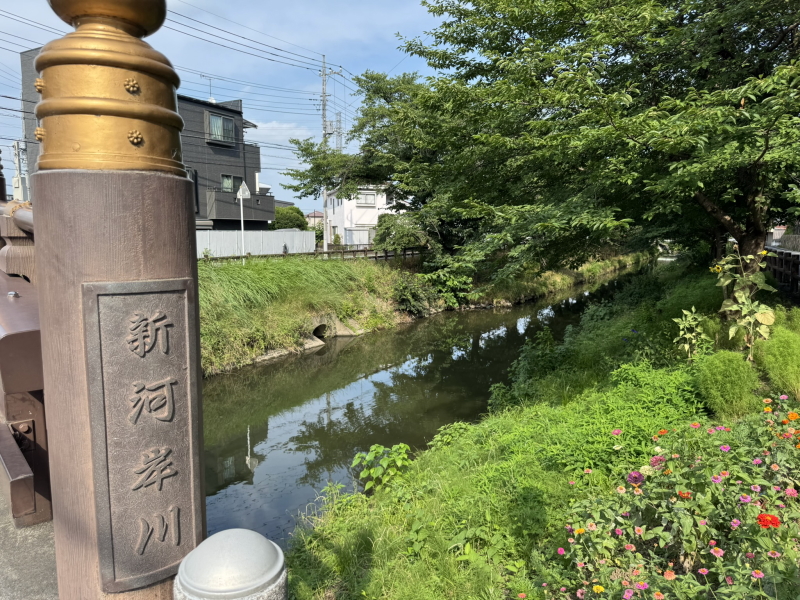The role of rivers and urban growth: why Kawagoe was a logistics hub
Known today as “Little Edo” for its preserved Edo-period townscape, Kawagoe once flourished as a city of water. During the Edo period through the early Meiji era, the Shin-Gashi River played a crucial role as a transportation artery that supported Kawagoe’s economy, daily life, and growth as an urban center.

Geography and Origin of the Shin-Gashi River
The Shin-Gashi River is part of the Arakawa River system. Branching from the Iruma River, it flows north of Kawagoe City and merges with the Sumida River near Tokyo’s Itabashi and Kita wards. Stretching about 50 kilometers, it functioned as a “water highway” directly connecting Kawagoe with Edo (modern-day Tokyo).
Historically, the river’s course was slightly different from today’s. Water once flowed from Lake Isanuma, east of the city center, passed near Kawagoe Castle, and merged with the Arakawa River. Locals even distinguished the two waterways by calling the Arakawa Sotogawa (“outer river”) and the Shin-Gashi Uchigawa (“inner river”), reflecting how deeply the river was woven into everyday life.
The Beginning and Expansion of River Transport
River transport along the Shin-Gashi began in earnest in 1638, when construction materials for rebuilding the Senba Toshogu Shrine were carried by boat. Before that, all goods had to be transported by land, which took several days to reach Edo. Water transport dramatically reduced travel time and cost, transforming Kawagoe into a major logistics hub linking it directly to the capital.
By the mid-17th century, projects were undertaken to maintain adequate water flow, and five key ports—Kami-Shingashi, Shimo-Shingashi, Ogi, Terao, and Ushigo—were established. Downstream, additional ports such as Fukuoka, Koichiba, Hebiki, Miyato, and Negishi expanded the network. Through this roughly 30-kilometer water route, rice, timber, and vegetables from Kawagoe were shipped to Asakusa and Nihonbashi in Edo, while daily goods and fertilizers made the return journey upstream.

Types of Boats and the Flow of Goods
The boats used on the Shin-Gashi were Takase-bune—flat-bottomed vessels capable of carrying 15 to 16 tons (around 250–300 sacks of rice). There were several types: Namibune (ordinary cargo boats), Hayabune (fast boats), Kyūsen (express boats), and Tobikiri-bune (super-express boats).
The Tobikiri-bune were considered luxurious. Wealthy merchants in Kawagoe often ordered fresh seafood from Edo to be shipped by these fastest vessels—a symbol of both status and the close connection between the two cities.
Travel times also varied. A Namibune took 7 to 20 days for a round trip, while Kyūsen boats completed the same route in just 3 to 4 days, and Tobikiri-bune in about 2 days. From Kawagoe, goods such as rice, wheat, sweet potatoes, and timber were sent to Edo, while fertilizers, textiles, and household goods came back upstream. This reciprocal exchange sustained Kawagoe’s economic growth for centuries.
Economic Prosperity and the Flourishing of “Little Edo”
Thanks to this thriving river trade, Kawagoe evolved from a castle town into a prosperous commercial city. Local merchants quickly adapted to Edo’s consumer needs, earning a reputation for reliability and quality. The city’s iconic kurazukuri (earthen-walled storehouses) that line today’s streets are enduring symbols of this wealth and success.
Kawagoe also developed warehouses, inns, and wholesalers along the river, forming a dense logistical network. By the late Edo period, local specialties such as Kawagoe Imo (sweet potatoes) and Kawagoe Silk were widely distributed through this waterway, spreading the city’s fame throughout the Kanto region.
Decline of River Transport and Transition
With the advent of railways and modern roads in the Meiji era, river transport gradually declined. By around 1886, express and fast boats had disappeared, leaving only a few slow cargo boats. As transportation shifted to land routes, Kawagoe’s economic focus also began to change.
Yet, remnants of that waterborne past remain. Old port sites and former boat warehouses can still be found along the Shin-Gashi River, quietly preserving the memory of Kawagoe’s days as a “water city.” Even today, walking along the river near Hikawa Shrine offers a glimpse into the town’s enduring relationship with water.
The Shin-Gashi River Today and Cultural Revitalization
In modern times, the Shin-Gashi River has been restored for flood control, environmental conservation, and recreation. Its riverbanks serve as pleasant walking trails where cherry blossoms bloom in spring. Local festivals, such as the Shingashi River Boat Festival and community river-cleaning events, aim to reconnect residents and visitors with the city’s forgotten maritime heritage.
The Meaning of the River in Kawagoe’s Urban Development
The history of Kawagoe clearly shows that rivers are not merely natural features—they are the very framework shaping a city’s economy, culture, and identity. The Shin-Gashi River was more than a means of transport; it was the lifeblood of Kawagoe’s growth and a symbol of the deep ties between Edo and its satellite towns.
When visiting Kawagoe, take time to walk along the Shin-Gashi River. You’ll sense the echoes of boats gliding through the water and imagine the bustling scenes of merchants connecting Edo and Kawagoe—a living trace of the “Little Edo by the River.”
Would you like me to make a native-level polished version (for publication on an English tourism website, with SEO phrases such as “Kawagoe travel,” “Little Edo history,” “Shingashi River,” etc.)? It would read more naturally to international readers.

